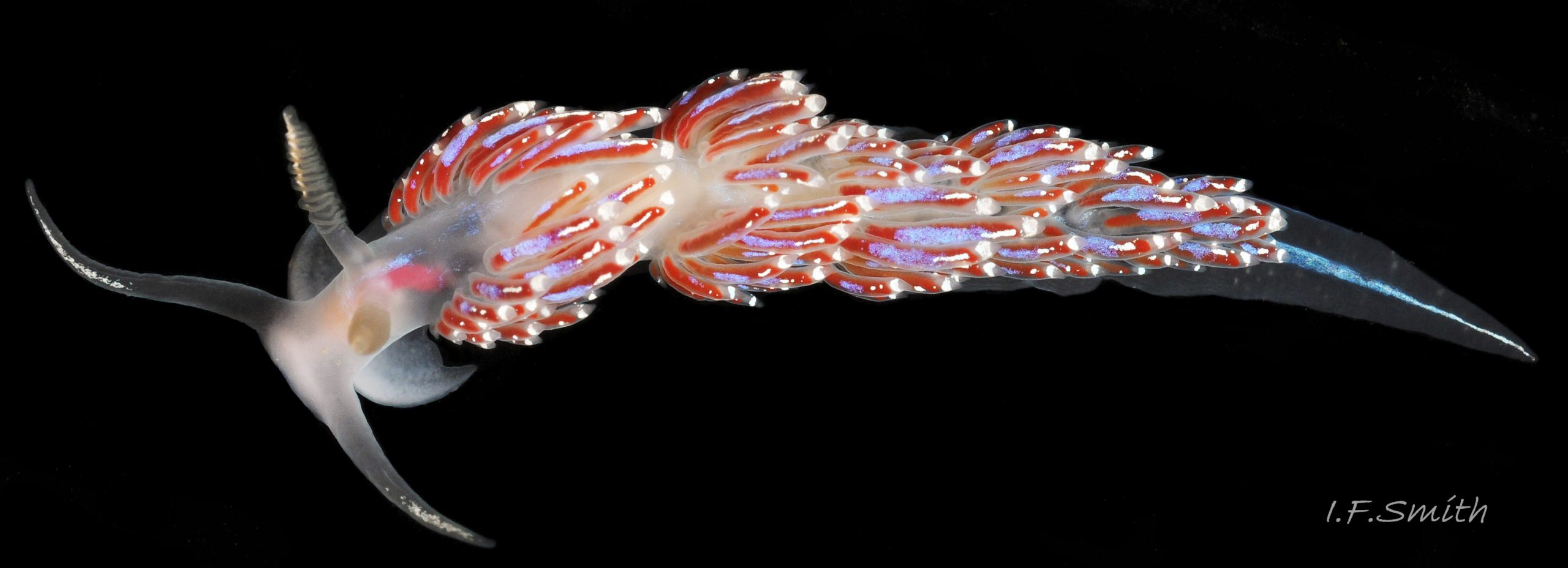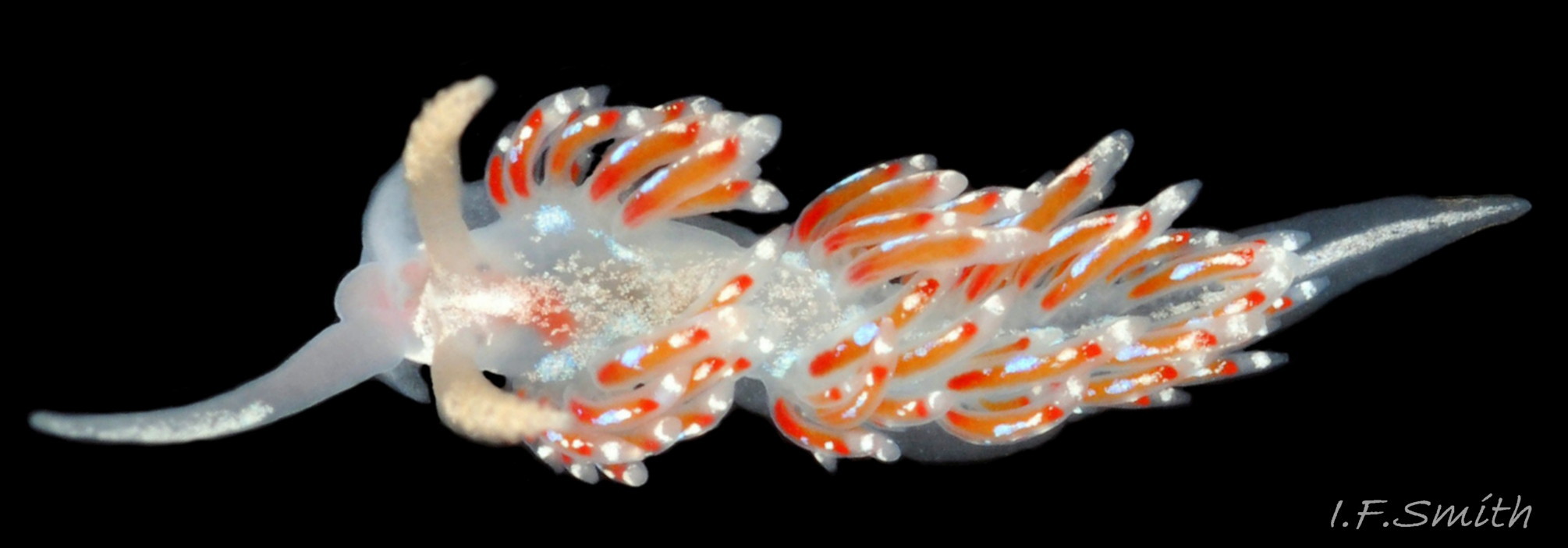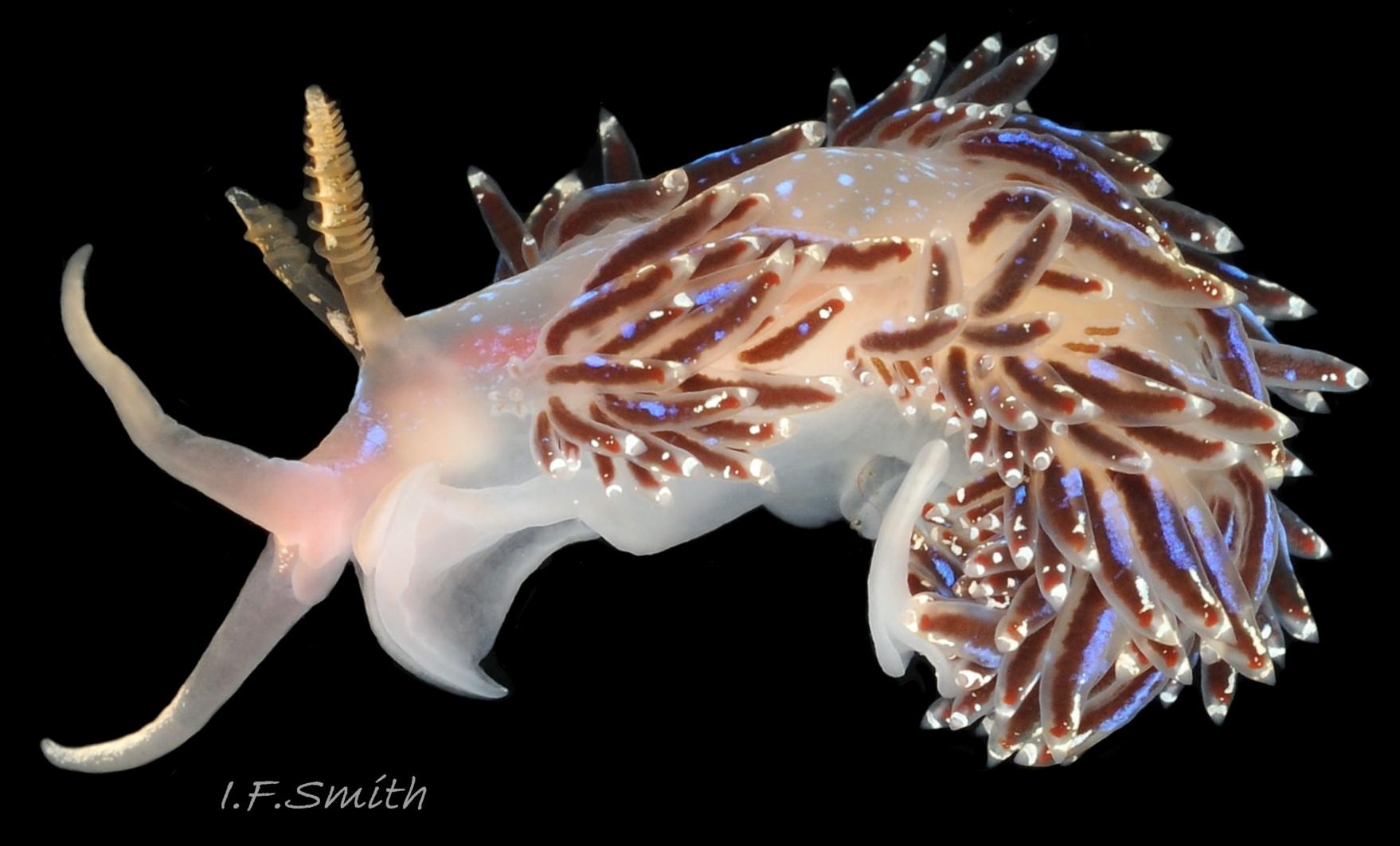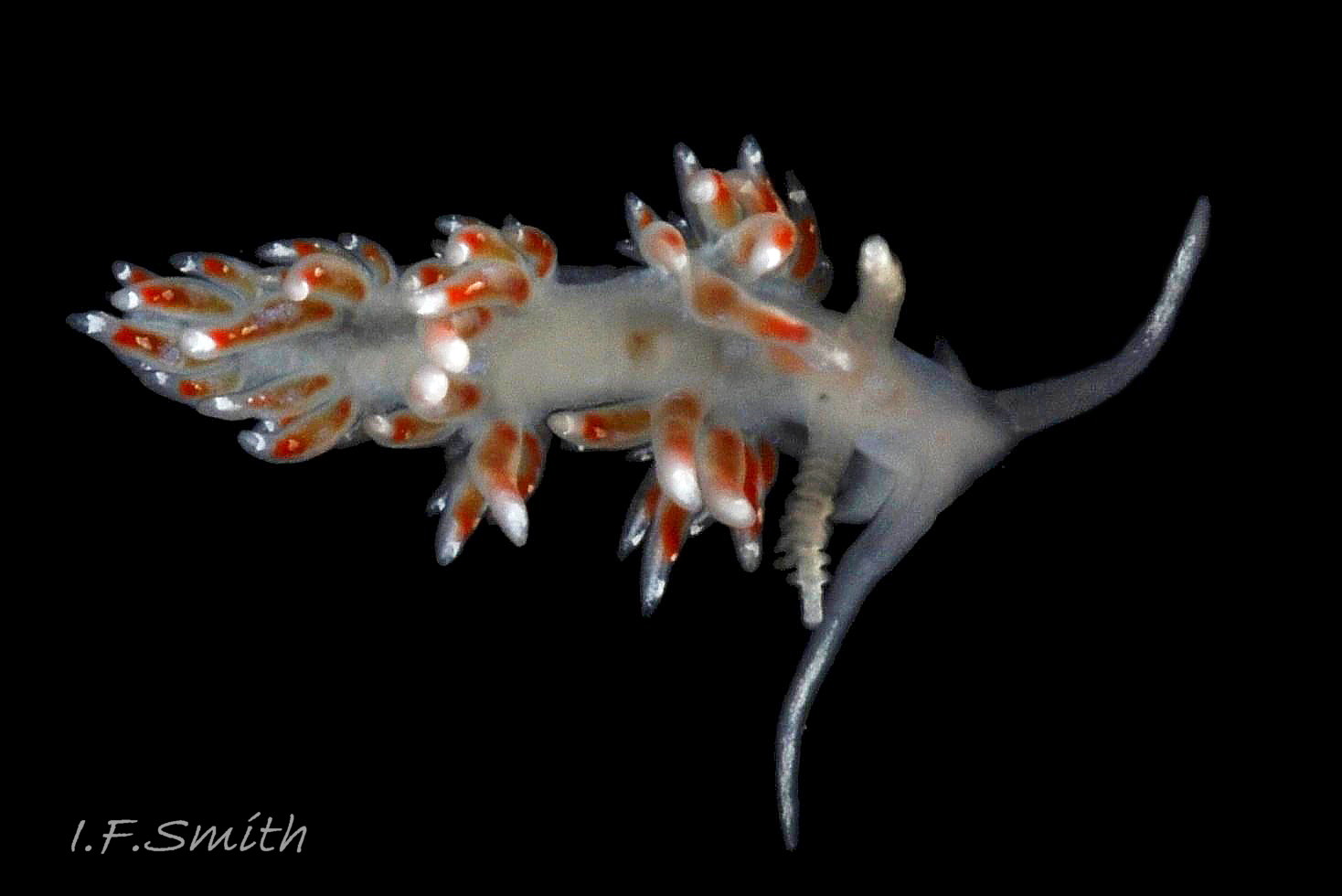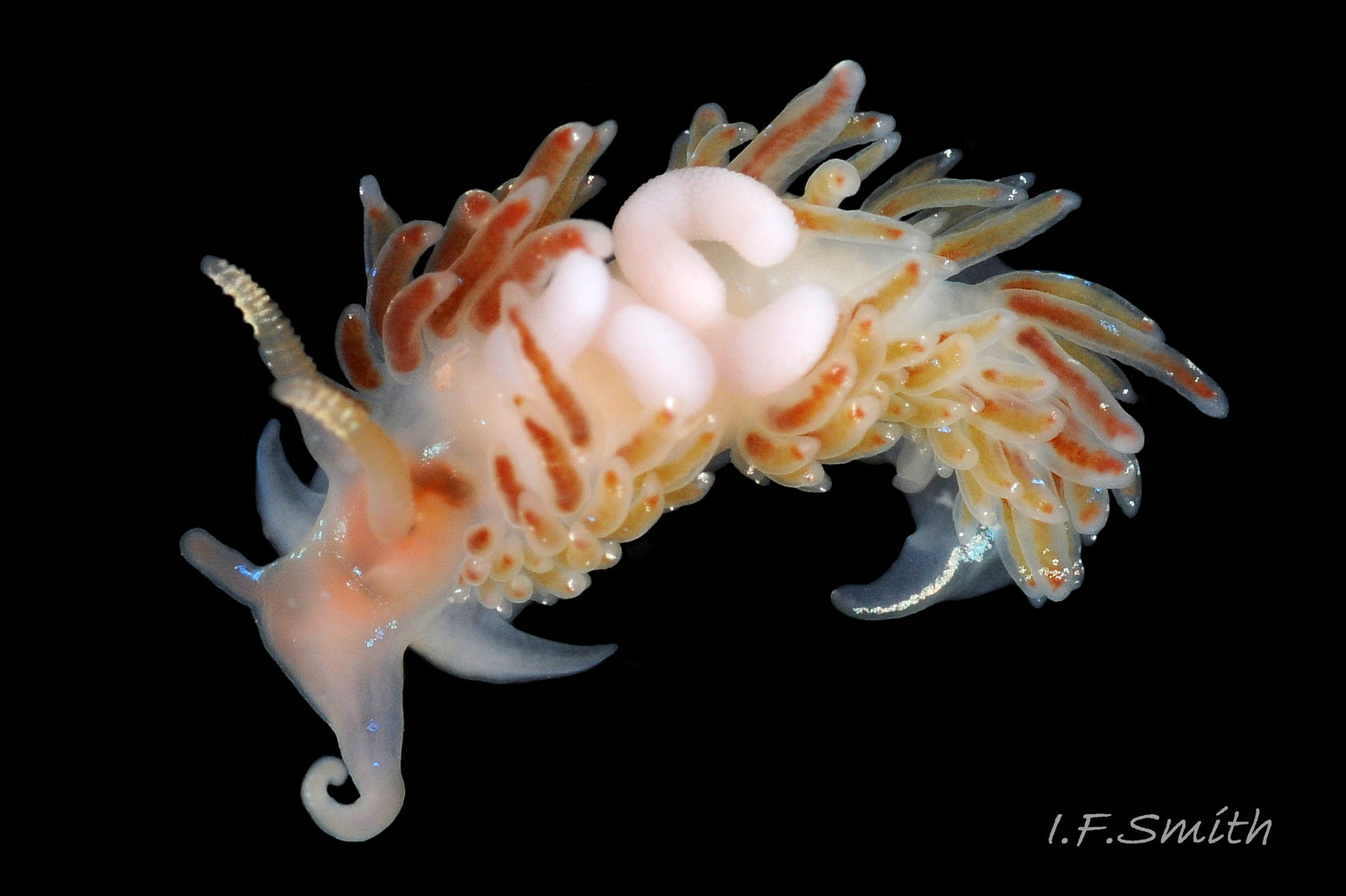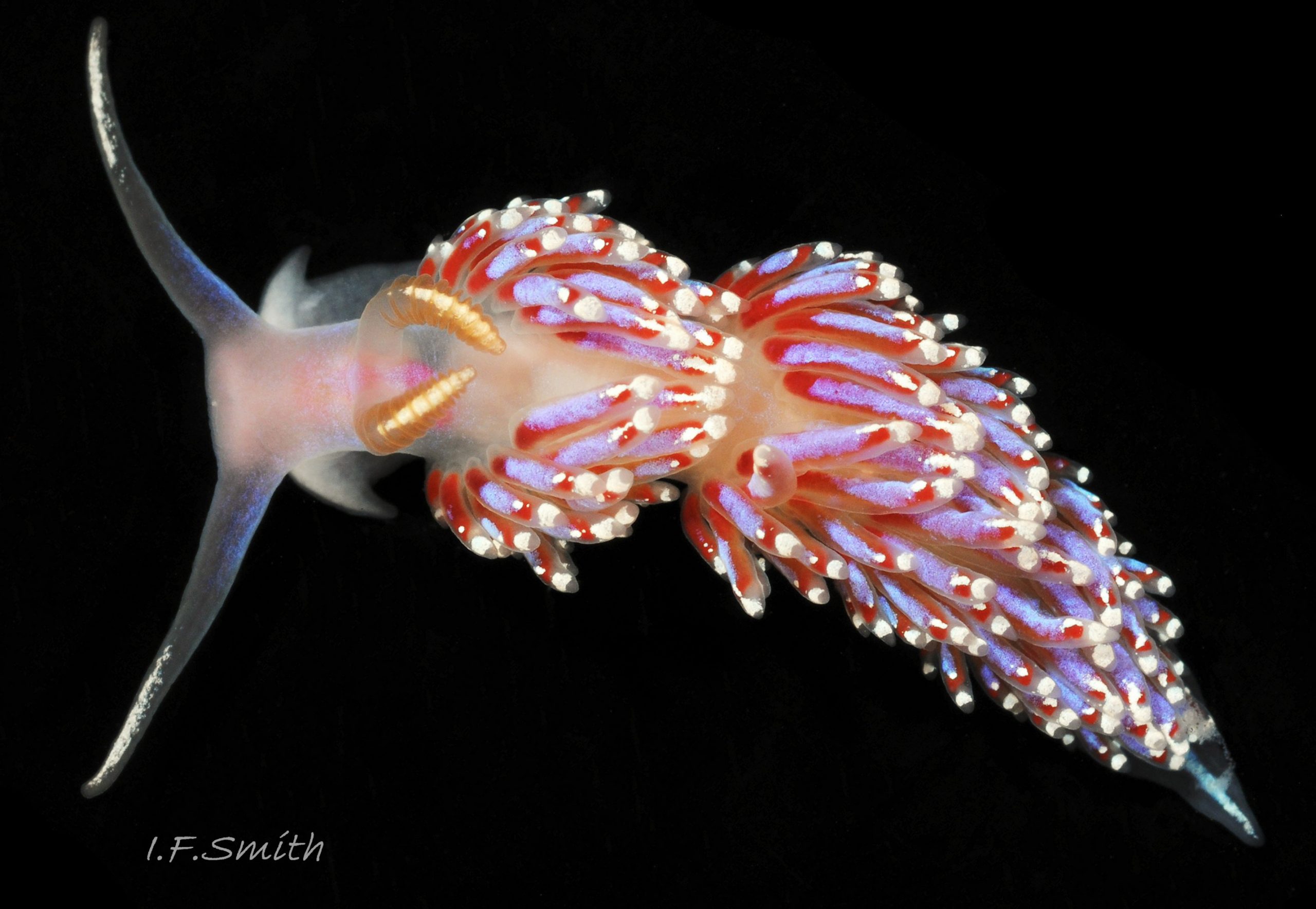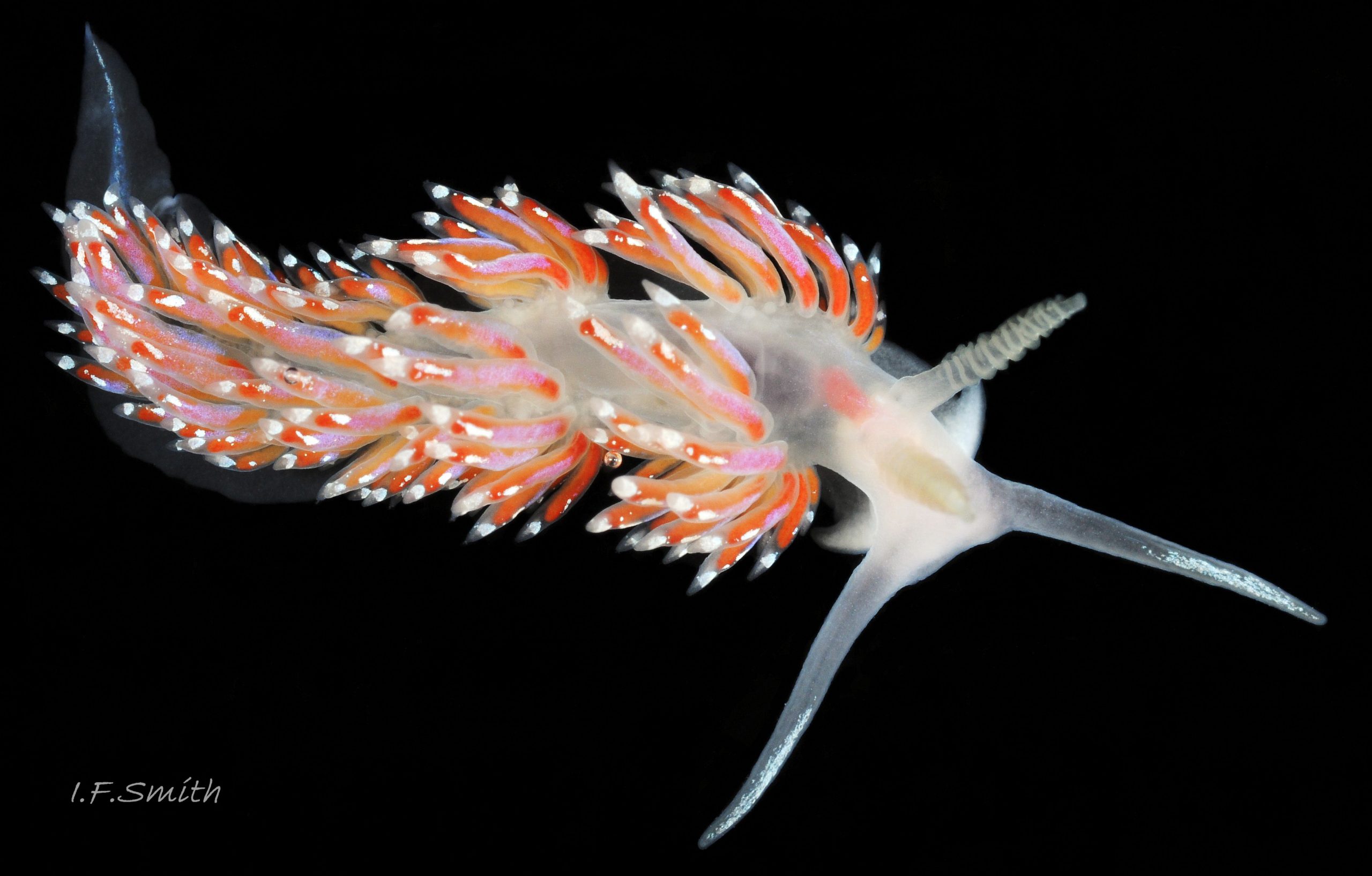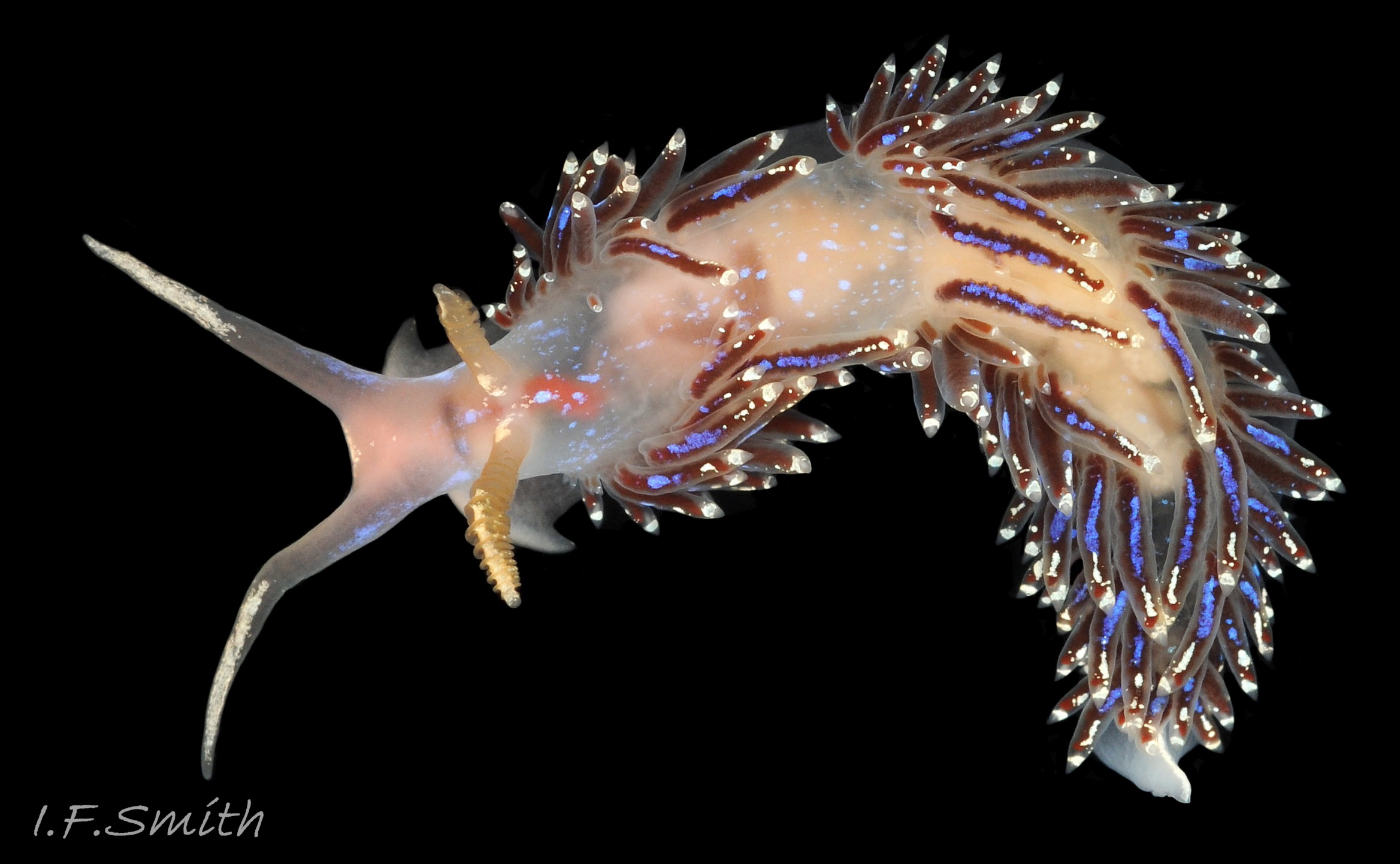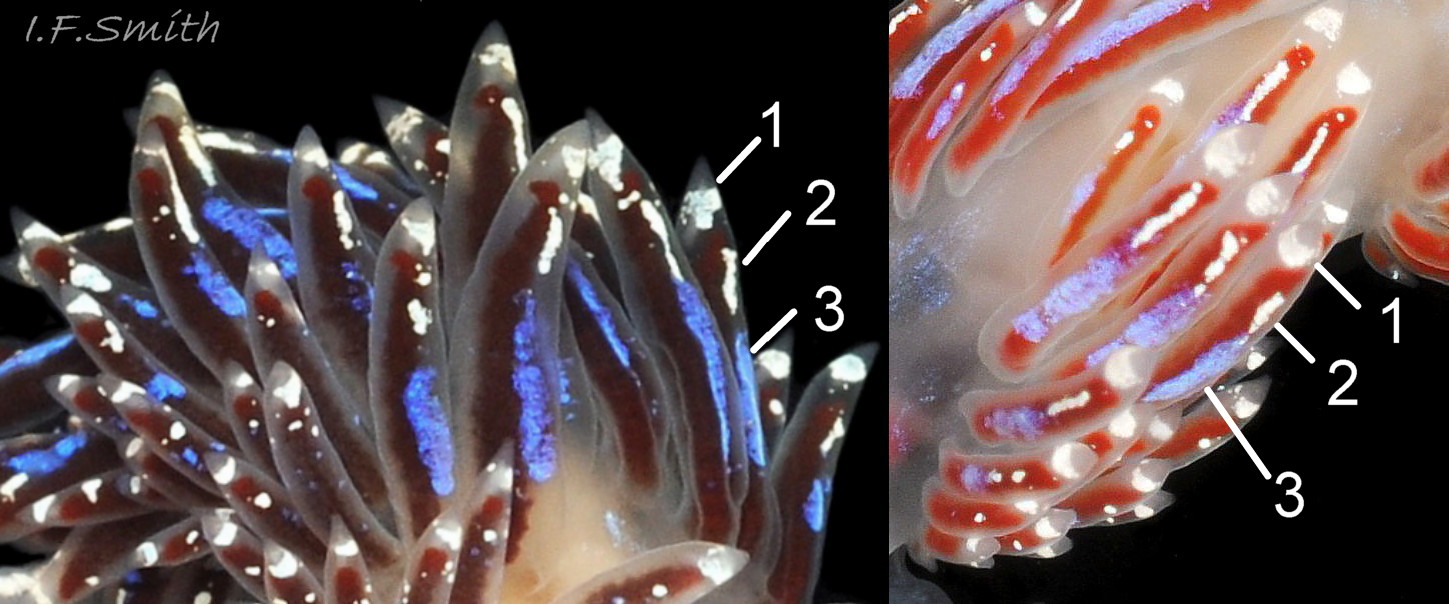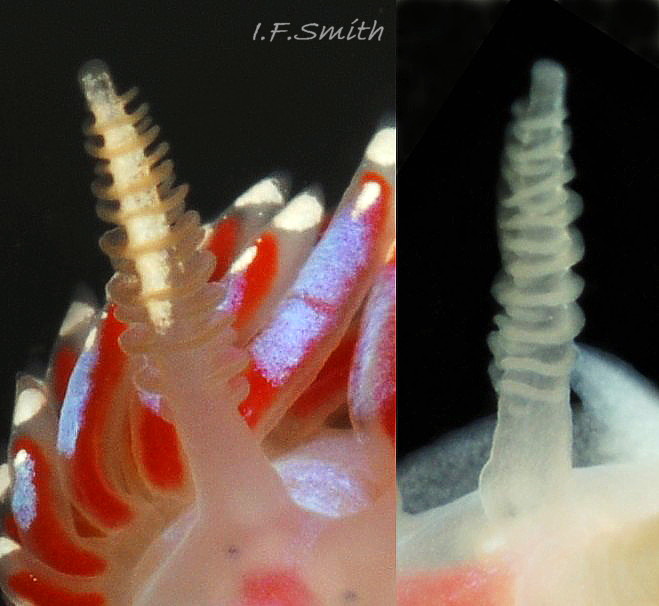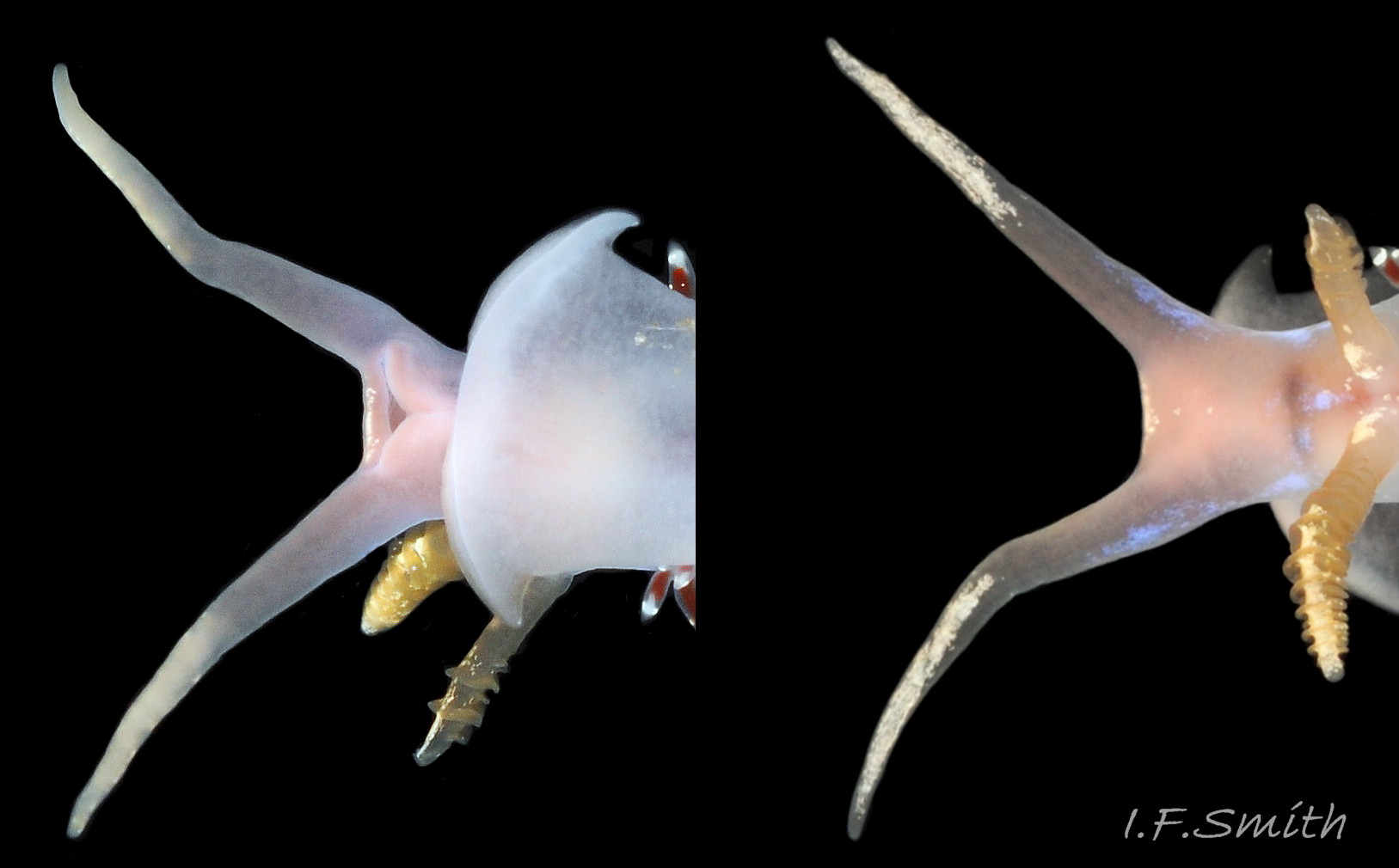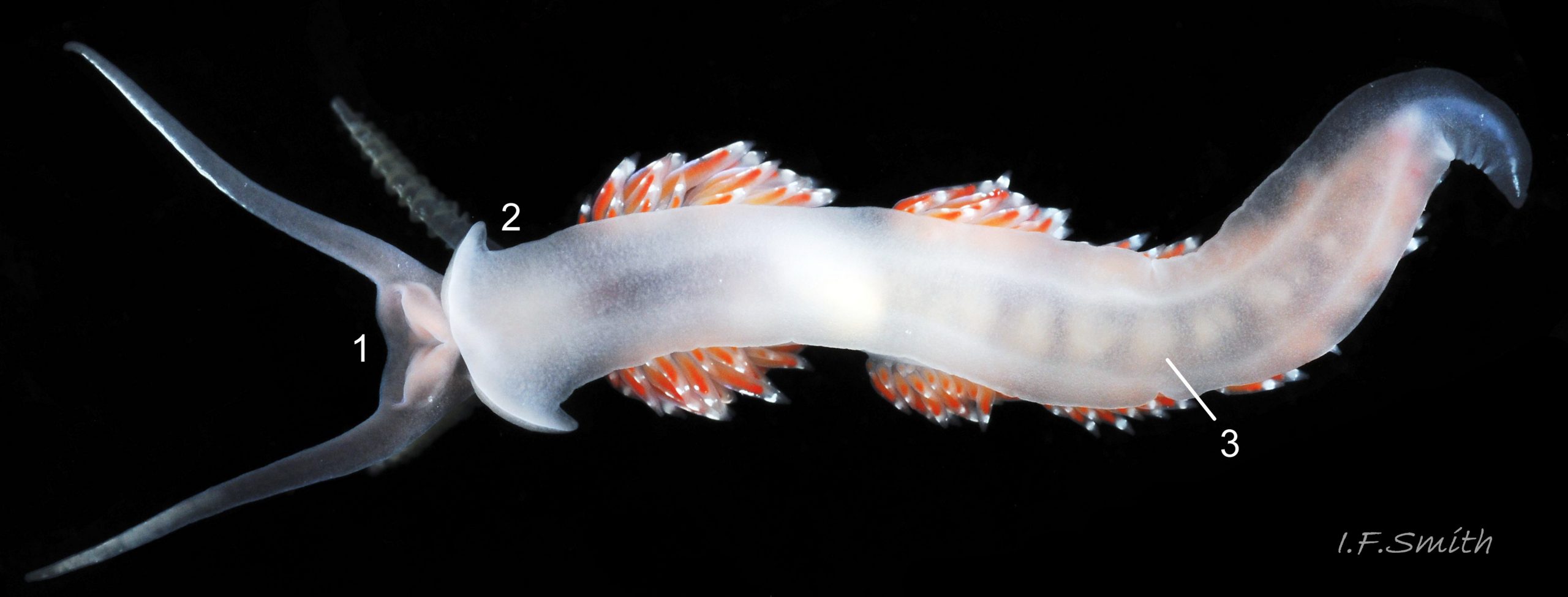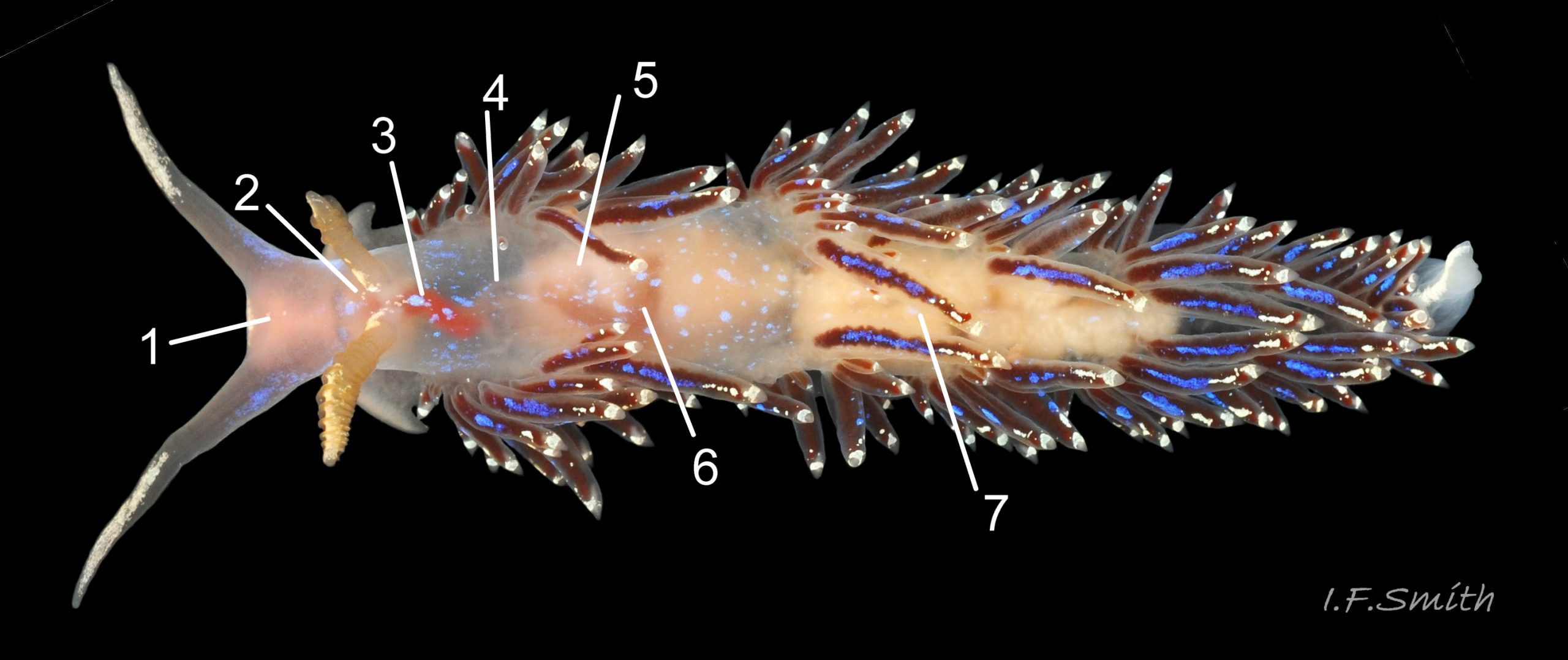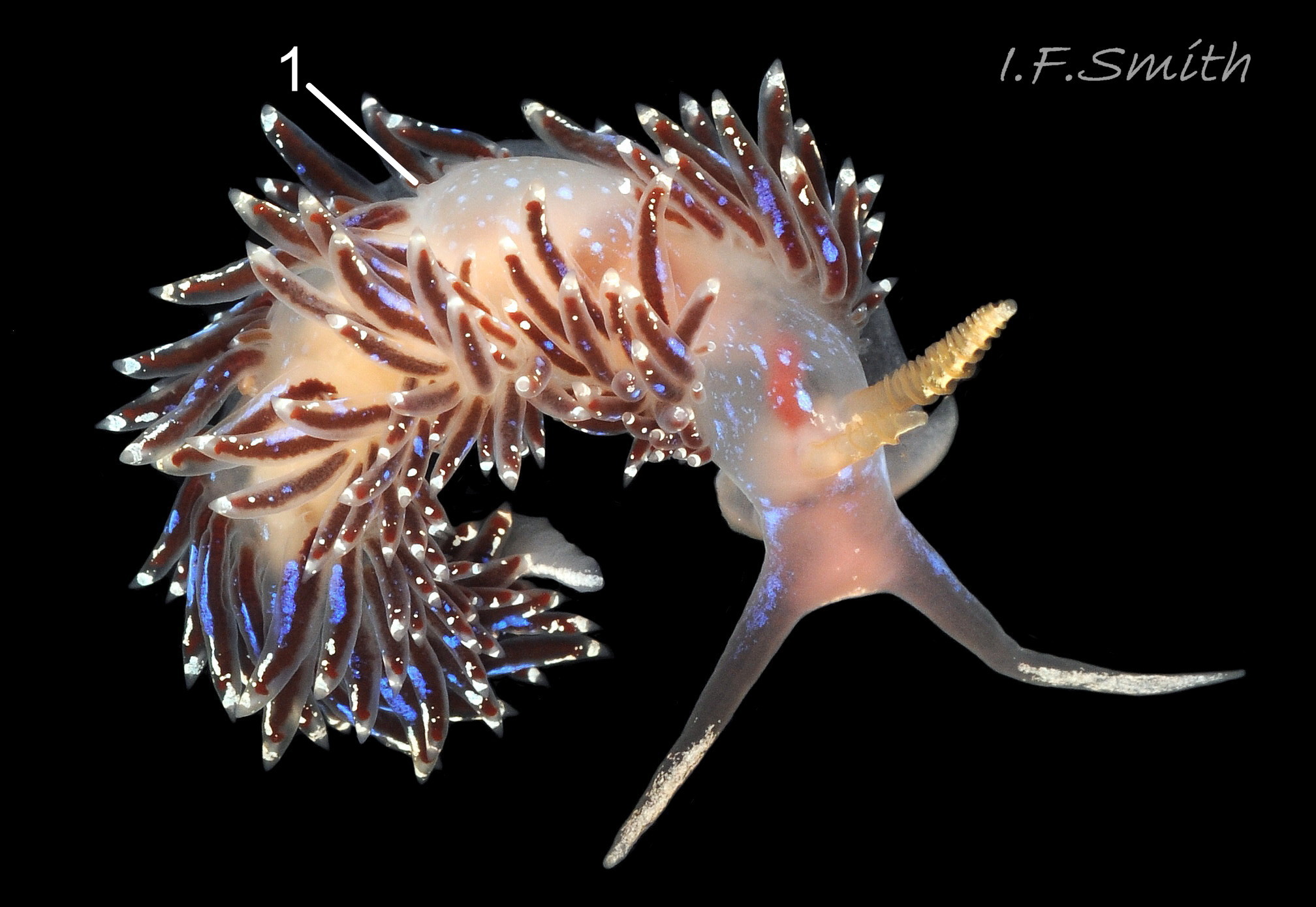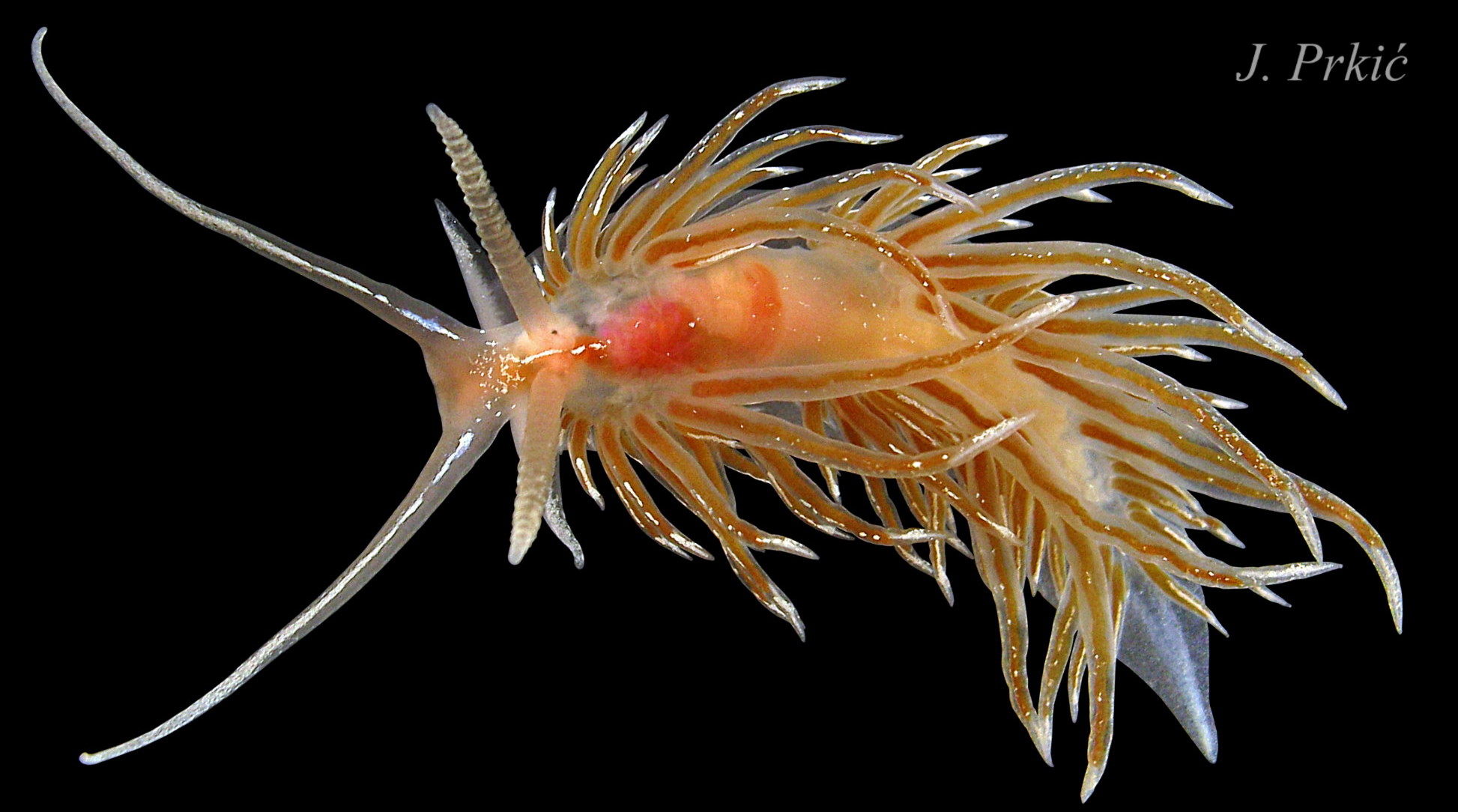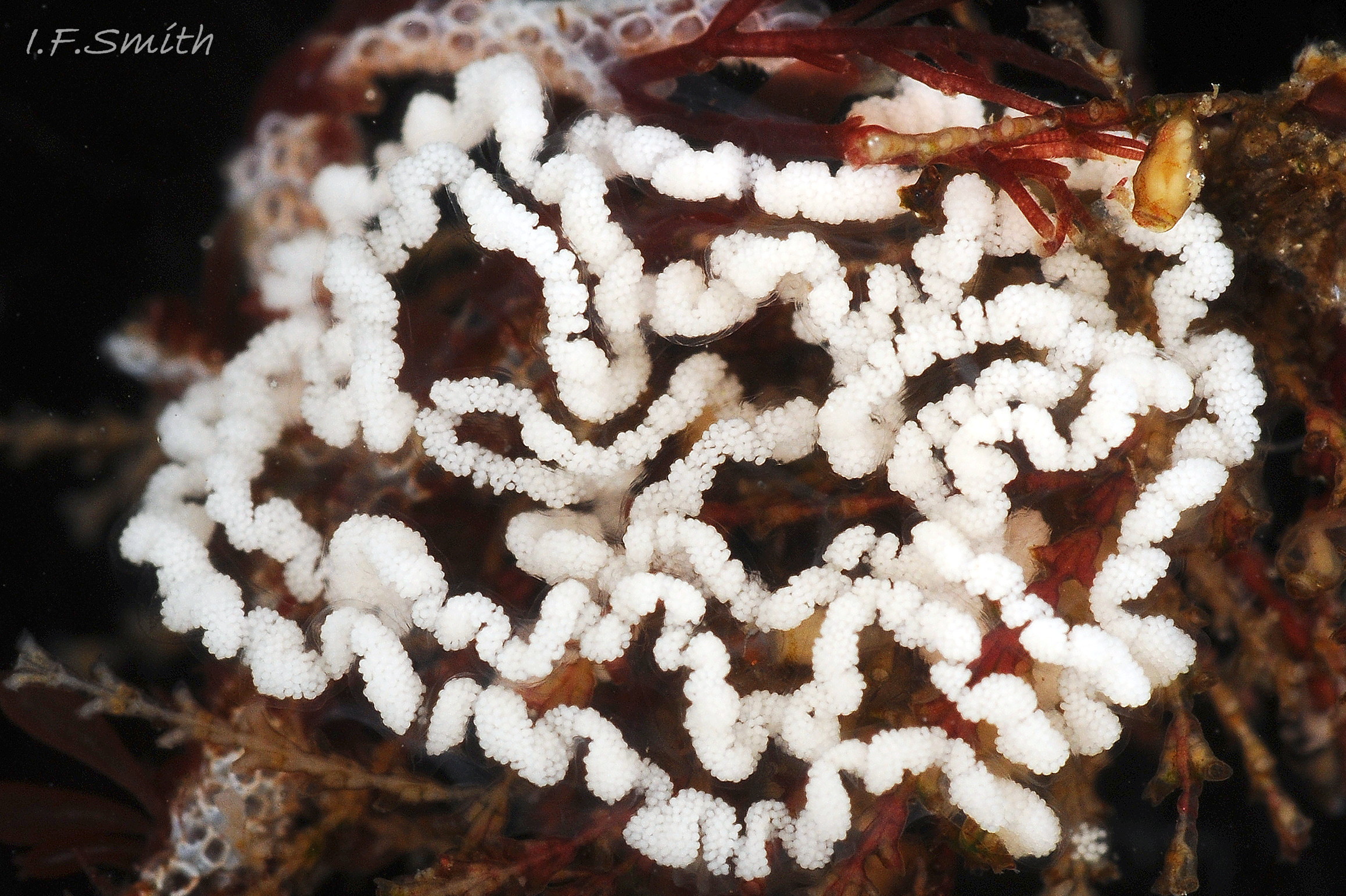Click image to enlarge with full caption. Main text below slider.
Facelina auriculata (Müller, 1776)
PDF version available at: www.researchgate.net/publication/358738394_Facelina_auric…
Current taxonomy: World Register of Marine Species www.marinespecies.org/aphia.php?p=taxdetails&id=153375
Synonyms: Doris auriculata Müller, 1776; Facelina coronata (Forbes & Goodsir, 1839).
Meaning of name
Facelina = lined face (rhinophores), auriculata = little ears (small propodial tentacles?)
GLOSSARY BELOW
Description
The slender body grows up to 38 mm long and is about 8X longer than the width when extended 01 Facelina auriculata . It is translucent white with a medial line of white pigment on the tail and variable amounts of opaque white freckling scattered over the body 02 Facelina auriculata . The white pigmented and other surfaces have variable amounts of light to dark blue iridescence 03 Facelina auriculata , but it may be absent from young juveniles 04 Facelina auriculata or much reduced on adults in poor condition 05 Facelina auriculata .
The cerata usually conceal the posterior half of the body 06 Facelina auriculata . They are arranged in distinct groups on each side of the body with a clear gap between the first and second clumps 07 Facelina auriculata . They are semi-transparent whitish, revealing the yellow, orange 10 Facelina auriculata , red 06 Facelina auriculata or brown 08 Facelina auriculata internal digestive gland which extends up each ceras. On the anterior of the almost transparent tip there is an irregular patch of white surface pigment which, on some, continues round to the posterior 09 Facelina auriculata . Lower down, on the anterior of the part occupied by the digestive gland, there is an irregular splash of white surface pigment which is not usually connected to the patch on the tip. Further down the anterior there is usually a longitudinal band of iridescent dark or light blue 09 Facelina auriculata , pink, purple 10 Facelina auriculata or pale mauve-pink 07 Facelina auriculata . The cerata of specimens from deep water may have the most extensive and darkest iridescence, and it may be absent from young juveniles 04 Facelina auriculata or much reduced on adults in poor condition 05 Facelina auriculata . The stem of the rhinophores is translucent white with lamellae which often alternate between complete and smaller, incomplete disks 11 Facelina auriculata . Lamellae vary from whitish to orange-brown, and there is often a cigar-shape stripe of white pigment on the distal half of the anterior.
The head is translucent white, often with some iridescence, except for the pink flesh of the outer lips and the overlying anterior of the head 12 Facelina auriculata . The oral tentacles are twice as long as the rhinophores. They are translucent white with white surface pigment distally and, often, iridescence proximally 12 Facelina auriculata .
The foot is long and slender, tapering to a posterior point 13 Facelina auriculata . It is broadest at the curved anterior where it has short, wide, propodial extensions/tentacles. The foot is translucent white dorsally 14 Facelina auriculata and on the sole.
Internal anatomy may be visible through the translucent body 15 Facelina auriculata & 16 Facelina auriculata . The buccal mass which operates the jaws and radula is a similar pink to that of the flesh of the anterior. An internal black eye at the base of each rhinophore may be faintly discernible on adults in lateral 16 Facelina auriculata or anterior view 17 Facelina auriculata . Eyes are more often dorsally visible on young 10 Facelina auriculata . The red (brown when young 10 Facelina auriculata ) anterior of the oesophagus leads backwards at an angle to the left from the buccal mass towards the stomach. Sometimes the colourless posterior of the oesophagus can be discerned 15 Facelina auriculata . The intestine may be visible overlying the stomach. The large white or pink ovotestes occupy most of the posterior half of the body and may be seen dorsally, laterally and through the sole 13 Facelina auriculata . There is a slightly raised mound over the pericardium containing the heart 18 Facelina auriculata .
Key identification features
Facelina auriculata (Müller, 1776) 01 Facelina auriculata .
The most consistent differentiating feature is ‘4’.
1) Slender body, when extended, length is about 8 X width.
2) Cerata rarely more than 25% of body length so only slightly overlap adjacent clumps, which are usually neat, compact and more clearly defined than on F. bostoniensis.
3) Usually, but not always, some blue iridescence on cerata and, often, on head and body.
4) Subapical, opaque white band on cerata is amorphous, not shield-shaped. Usually, there are white pigment splashes down the front of cerata 09 Facelina auriculata .
5) The lamellated rhinophores never have a streak of white pigment between them (Thompson & Brown, 1984), unless a specimen with lots of general pigment marks 02 Facelina auriculata .
6) Propodial extensions much shorter and less slender than on F. bostoniensis 13 Facelina auriculata .
7) Found in Europe from northern Norway to the western Mediterranean, not in America.
Similar species
Further information about F. bostoniensis and F. vicina in Smith (2020).
Facelina bostoniensis 20 Facelina auriculata .
The most consistent differentiating feature is ‘4’.
1) Body broad, when extended, length is about 4 X width 19 Facelina auriculata .
2) Many of the linear cerata are between 33% and 50% of the body length and are held loosely at various angles. Poorly defined clumps are obscured by overlapping..
3) Usually no blue iridescence on cerata , but quite frequently some on other parts (Couthouy, 1838) and blue cerata do occur, especially at depth in clean water in west Ireland and Norway. (Molecular investigation of the latter is desirable.)
4) Subapical, opaque white band on cerata is narrow at posterior and shield-shape at anterior. No white pigment splashes down cerata, but sometimes a few small, white spots 21 Facelina auriculata.
5) The lamellated rhinophores nearly always have a streak or some spots of white pigment between and in front them.
6) Well developed, slender, flexed propodial tentacles 22 Facelina auriculata.
7) Found on both sides of the North Atlantic, possibly not in the Mediterranean.
Facelina vicina (Bergh, 1882)
Strong iridescence 23 Facelina auriculata and (rare) no iridescence 24 Facelina auriculata
The most consistent differentiating feature is ‘4’.
1) Broad body, length 4.7 X width.
2) Cerata up to 58% body length.
3) Dorsum of tail, proximal half of oral tentacles and anterior face of cerata have variable amounts of bluish iridescence; a few have none.
4) Cerata have an opaque white tip with an opaque white line or dots running down the anterior from it.
5) The lamellated rhinophores have a median row of discrete, elongated white spots between and behind them, almost to the pericardium. [Length varies in Croatia. On some the line also projects forwards from the rhinophores.]
6) Propodial tentacles protrude 3 mm each side of foot. [Similar lengths, relative to body size, on Croatian specimens.]
7) Only known from the Mediterranean and its branches. Identifications relying on iridescence alone are not sufficient as all three species have widely variable amounts. Molecular sequencing is needed to ascertain if it occurs in the Atlantic.
Other features of F. vicina
Almost colourless body shows viscera, such as the elongated, yellow-white ovotestes visible through the posterior half of the sole.
Bright rosy red head, particularly intense on the front and under the neck [missing from some Croatian specimens].
Long oral tentacles nearly twice as long as rhinophores and 25% body length (Bergh, 1882. Longer on some Croatian specimens.)
Habits and ecology/b>
F. auriculata lives sublittorally and near LWS on rocky shores where its prey occurs; Tubularia indivisa, Laomedea flexuosa and Obelia and other aeolids.
It is parasitised internally, and its condition adversely affected, by copepods, the egg masses of which protrude from the body 05 Facelina auriculata .
It is a simultaneous hermaphrodite. Spawn is laid from April to October as a Grecian key line arranged in a spiral of about six turns (Thompson & Brown, 1984). The spiral may be untidy and the ova can give it a granular appearance 25 Facelina auriculata . Shelled veliger larvae drift as plankton before settling on the sea floor and transforming into adults.
Distribution and status
F. auriculata occurs from the north-western Mediterranean to the north of Norway GBIF map www.gbif.org/species/2292198 . In Britain, F. auriculata is frequent at LWS, but it is commonest sublittorally below 15 m (Thompson & Brown, 1984). UK NBN map species.nbnatlas.org/species/NHMSYS0021056136
Acknowledgements
I am indebted to Simon Taylor for providing specimens for photography, and I gratefully thank Jakov Prkić for use of his images.
References and links
Abad, M. , Díaz-Agras, G., Moreira J., García-Regueira A., Tato R., Candás M., Lucas Y., Cunha X. & Urgorri V. 2011. Natural history of Lomanoticola brevipes Hancock & Norman, 1863, (Copepoda, Poecilostomatoidea, Splanchnotrophidae) at the Ría de Ferrol (Galicia, NW Iberian Peninsula): external anatomy, behaviour and reproduction. 11th International Conference on Copepoda, Mérida, Mexico. file:///C:/Users/Ian/AppData/Local/Temp/2011-Abadetal.11thInternationalConferenceonCopepoda.pdf
Alder, J. & Hancock, A. 1845-1855. A monograph of the British nudibranchiate mollusca. London, Ray Society. (As Eolis coronata.) www.biodiversitylibrary.org/item/131598#page/330/mode/1up
Anderson, J. Facelina auriculata (Müller, 1776), Scottish nudibranchs & Sea Slugs. www.nudibranch.org/Scottish%20Nudibranchs/facelina-auricu… Accessed 16 February 2022. Wide range of colour forms shown.
Smith, I.F. 2022. Facelina bostoniensis (Couthouy, 1838) Identification and Biology. PDF www.researchgate.net/publication/358694348_Facelina_bosto…
Thompson, T.E. & Brown, G.H. 1984. Biology of opisthobranch molluscs 2. London, Ray Society.
Current taxonomy: World Register of Marine Species www.marinespecies.org/aphia.php?p=taxdetails&id=153375
Glossary
buccal mass = anterior of digestive system including a radula, odontophore and muscles.
cerata = (sing. ceras) lobes on dorsum of aeolids and some other seaslugs.
digestive gland = organ in gastropods which acts like the liver and pancreas in mammals to absorb food. On aeolids it branches into each ceras.
distal = away from centre of body or from point of attachment.
hermaphrodite, simultaneous = individual acts as both male and female at the same time with similar partner(s).
lamellae = small plates on rhinophores.
LWS = low water spring tide, and level it falls to; two periods of a few days each month when tide falls lowest.
oesophagus = tube from mouth to stomach.
ovotestis = (pl. ovotestes) hermaphrodite gland serving as both ovary and testis.
pericardium = sac containing heart, often visible behind rhinophores in aeolid sea slugs.
propodium = anterior portion of gastropod foot.
propodial = at the front of the foot.
proximal = towards the centre of the body or point of attachment.
rhinophore = chemo-receptor tentacle; many sea slugs have a pair on top of the head.
radula = chitinous ribbon of teeth; extended on odontophore to rasp food.
veliger = shelled larva of marine gastropod or bivalve mollusc which moves by action of cilia on a velum (bilobed flap).
